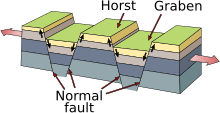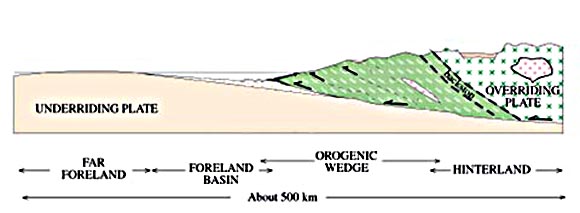Tectonic subsidence is the sinking of the Earth's crust on a large scale, relative to crustal-scale features or the geoid. The movement of crustal plates and accommodation spaces produced by faulting brought about subsidence on a large scale in a variety of environments, including passive margins, aulacogens, fore-arc basins, foreland basins, intercontinental basins and pull-apart basins. Three mechanisms are common in the tectonic environments in which subsidence occurs: extension, cooling and loading.
Mechanisms
Extension

Where the lithosphere undergoes horizontal extension at a normal fault or rifting center, the crust will stretch until faulting occurs, either by a system of normal faults (which creates horsts and grabens) or by a system of listric faults. These fault systems allow the region to stretch, while also decreasing its thickness. A thinner crust subsides relative to thicker, undeformed crust.
Cooling

Lithospheric stretching/thinning during rifting results in regional necking of the lithosphere (the elevation of the upper surface decreases while the lower boundary rises). The underlying asthenosphere passively rises to replace the thinned mantle lithosphere. Subsequently, after the rifting/stretching period ends, this shallow asthenosphere gradually cools back into mantle lithosphere over a period of many tens of millions of years. Because mantle lithosphere is denser than asthenospheric mantle, this cooling causes subsidence. This gradual subsidence due to cooling is known as "thermal subsidence".
Loading
The adding of weight by sedimentation from erosion or orogenic processes, or loading, causes crustal depression and subsidence. Sediments accumulate at the lowest elevation possible, in accommodation spaces. The rate and magnitude of sedimentation controls the rate at which subsidence occurs. By contrast, in orogenic processes, mountain building creates a large load on the Earth's crust, causing flexural depressions in adjacent lithospheric crust.
Subduction erosion
Main article: Subduction erosionEnvironments
Tectonically inactive
These settings are not tectonically active, but still experience large-scale subsidence because of tectonic features of the crust.
Intracontinental basins



Intracontinental basins are large areal depressions that are tectonically inactive and not near any plate boundaries. Multiple hypotheses have been introduced to explain this slow, long-lived subsidence: long-term cooling since the breakup of Pangea, interaction of deformation around the edge of the basin and deep earth dynamics. The Illinois basin and Michigan basin are examples of intracontinental basins. Extensive swamps are sometimes formed along the shorelines of these basins, leading to the burial of plant matter that later forms coal.
Extensional
Tectonic subsidence can occur in these environments as the crust thinning.
Passive margins
Successful rifting forms a spreading center like a mid-ocean ridge, which moves progressively further from coastlines as oceanic lithosphere is produced. Due to this initial phase of rifting, the crust in a passive margin is thinner than adjacent crust and subsides to create an accommodation space. Accumulation of non-marine sediment forms alluvial fans in the accommodation space. As rifting proceeds, listric fault systems form and further subsidence occurs, resulting in the creation of an ocean basin. After the cessation of rifting, cooling causes the crust to further subside, and loading with sediment will cause further tectonic subsidence.
Aulacogens
Aulacogens occur at failed rifts, where continental crust does not completely split. Similar to the lithospheric heating that occurs during the formation of passive margins, subsidence occurs due to heated lithosphere sagging as spreading occurs. Once tensional forces cease, subsidence continues due to cooling.
Collisional
Tectonic subsidence can occur in these settings as the plates collide against or under each other.
Pull-apart basins
Pull-apart basins have short-lived subsidence that forms from transtensional strike-slip faults. Moderate strike-slip faults create extensional releasing bends and opposing walls pull apart from each other. Normal faults occur, inducing small scale subsidence in the area, which ceases once the fault stops propagating. Cooling occurs after the fault fails to propagate further following the crustal thinning via normal faulting.
Forearc basins

Forearc basins form in subduction zones as sedimentary material is scraped off the subducting oceanic plate, forming an accretionary prism between the subducting oceanic lithosphere and the overriding continental plate. Between this wedge and the associated volcanic arc is a zone of depression in the sea floor. Extensional faulting due to relative motion between the accretionary prism and the volcanic arc may occur. Abnormal cooling effects due to the cold, water-laden downgoing plate as well as crustal thinning due to underplating may also be at work.
Foreland basins
Foreland basins are flexural depressions created by large fold thrust sheets that form toward the undeformed continental crust. They form as an isostatic response to an orogenic load. Basin growth is controlled by load migration and corresponding sedimentation rates. The broader a basin is, the greater the subsidence is in magnitude. Subsidence is increased in the adjacent basin as the load migrates further into the foreland, causing subsidence. Sediment eroded from the fold thrust is deposited in the basin, with thickening layers toward the thrust belt and thinning layers away from the thrust belt; this feature is called differential subsidence.
References
- Makhous, M.; Galushkin, Y. (2005). Basin analysis and modeling of the burial, thermal and maturation histories in sedimentary basins. Editions TECHNIP. p. 66. ISBN 978-2-7108-0846-6. Retrieved 18 November 2011.
- ^ Xie, Xiangyang; Heller, Paul (2006). "Plate tectonics and basin subsidence history". Geological Society of America Bulletin. 121 (1–2): 55–64. doi:10.1130/b26398.1.
- ^ Ceramicola, S.; Stoker, M.; Praeg, D.; Shannon, P.M.; De Santis, L.; Hoult, R.; Hjelstuen, B.O.; Laberg, S.; Mathiesen, A. (2005). "Anomalous Cenozoic subsidence along the 'passive' continental margin from Ireland to mid-Norway". Marine and Petroleum Geology. 22 (9–10): 1045–67. Bibcode:2005MarPG..22.1045C. doi:10.1016/j.marpetgeo.2005.04.005.
- Lee, E.Y., Novotny, J., Wagreich, M. (2019) Subsidence analysis and visualization: for sedimentary basin analysis and modelling, Springer.doi:10.1007/978-3-319-76424-5
- McKenzie, D (1978). "Some remarks on the development of sedimentary basins". Earth and Planetary Science Letters. 40 (1): 25–32. Bibcode:1978E&PSL..40...25M. CiteSeerX 10.1.1.459.4779. doi:10.1016/0012-821X(78)90071-7.
- Kim, Yeseul; Huh, Min; Lee, Eun Young (2020). "Numerical Modelling to Evaluate Sedimentation Effects on Heat Flow and Subsidence during Continental Rifting". Geosciences. 10 (11): 451. Bibcode:2020Geosc..10..451K. doi:10.3390/geosciences10110451. ISSN 2076-3263.
- Heine, Christian; Dietmar Müller, R.; Steinberger, Bernhard; Torsvik, Trond H. (2008). "Subsidence in intracontinental basins due to dynamic topography". Physics of the Earth and Planetary Interiors. 171 (1–4): 252–264. Bibcode:2008PEPI..171..252H. doi:10.1016/j.pepi.2008.05.008.
- Lee, Eun Young; Wagreich, Michael (2017-03-01). "Polyphase tectonic subsidence evolution of the Vienna Basin inferred from quantitative subsidence analysis of the northern and central parts". International Journal of Earth Sciences. 106 (2): 687–705. Bibcode:2017IJEaS.106..687L. doi:10.1007/s00531-016-1329-9. ISSN 1437-3262. S2CID 54965303.
- Mascle, Alain; Puigdefàbregas, Cai (1998). "Tectonics and sedimentation in foreland basins: Results from the Integrated Basin Studies project". Geological Society, London, Special Publications. 134 (1): 1–28. Bibcode:1998GSLSP.134....1M. doi:10.1144/GSL.SP.1998.134.01.02. S2CID 130915307.
